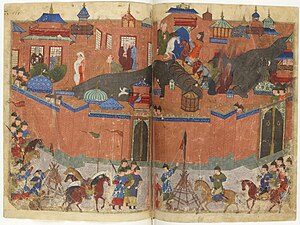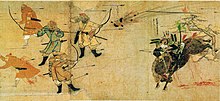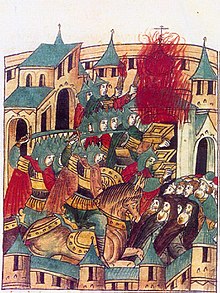Destruction under the Mongol Empire: Difference between revisions
GraniteSand (talk | contribs) Says who? If contemporary scholarship disagrees then include it here. |
|||
| Line 48: | Line 48: | ||
China reportedly suffered a drastic decline in population during the 13th and 14th centuries. Before the [[Mongol invasion]], Chinese dynasties reportedly had approximately 120 million inhabitants; after the conquest was completed in 1279, the 1300 census reported roughly 60 million people. The most likely is that in fact up to and around 30 million outstanding was posted outside in the army levies. The 92 Chinese cities destroyed by Mongols would not appear to account for this population fall, it might account for loss of 45 million people. While it is tempting to attribute this major decline solely to Mongol ferocity, scholars today have mixed sentiments regarding this subject. The South Chinese might likely account for some 40 million unregistered who, without passports, would not have appeared in the census. Entire peasant populations joining or enlisted for labour can result in a large population reduction due to food shortage problems. Scholars such as Frederick W. Mote argue that the wide drop in numbers reflects an administrative failure to record rather than a de facto decrease whilst others such as Timothy Brook argue that the Mongols created a system of enserfment among a huge portion of the Chinese populace causing many to disappear from the census altogether. Other historians like William McNeill and David Morgan argue that the Bubonic Plague was the main factor behind the demographic decline during this period. |
China reportedly suffered a drastic decline in population during the 13th and 14th centuries. Before the [[Mongol invasion]], Chinese dynasties reportedly had approximately 120 million inhabitants; after the conquest was completed in 1279, the 1300 census reported roughly 60 million people. The most likely is that in fact up to and around 30 million outstanding was posted outside in the army levies. The 92 Chinese cities destroyed by Mongols would not appear to account for this population fall, it might account for loss of 45 million people. While it is tempting to attribute this major decline solely to Mongol ferocity, scholars today have mixed sentiments regarding this subject. The South Chinese might likely account for some 40 million unregistered who, without passports, would not have appeared in the census. Entire peasant populations joining or enlisted for labour can result in a large population reduction due to food shortage problems. Scholars such as Frederick W. Mote argue that the wide drop in numbers reflects an administrative failure to record rather than a de facto decrease whilst others such as Timothy Brook argue that the Mongols created a system of enserfment among a huge portion of the Chinese populace causing many to disappear from the census altogether. Other historians like William McNeill and David Morgan argue that the Bubonic Plague was the main factor behind the demographic decline during this period. |
||
About half the population of [[Russians|Russia]] may have died during the [[Mongol invasion of Rus]]. This figure |
About half the population of [[Russians|Russia]] may have died during the [[Mongol invasion of Rus]]. This figure refers to the area of the modern republic of Ukraine.<ref>[http://www.parallelsixty.com/history-russia.shtml History of Russia, Early Slavs history, Kievan Rus, Mongol invasion]</ref> Colin McEvedy (''Atlas of World Population History, 1978'') estimates the population of [[European Russia]] dropped from 7.5 million prior to the invasion to 7 million afterwards.<ref>[http://users.erols.com/mwhite28/warstat0.htm#Mongol Mongol Conquests]</ref> |
||
Historians estimate that up to half of [[Hungary]]'s population of two million were victims of the [[Mongol invasion of Europe]].<ref>[http://www.britannica.com/blackhistory/article-34789 Welcome to Encyclopædia Britannica's Guide to History]</ref> |
Historians estimate that up to half of [[Hungary]]'s population of two million were victims of the [[Mongol invasion of Europe]].<ref>[http://www.britannica.com/blackhistory/article-34789 Welcome to Encyclopædia Britannica's Guide to History]</ref> |
||
Revision as of 15:12, 27 August 2014
This article may require cleanup to meet Wikipedia's quality standards. The specific problem is: formatting and readability. (August 2012) |

Destruction under the Mongol Empire quantifies death toll and infrastructure damage ensuing from the 13th century Mongol conquests. Historian Wei-chieh Tsai has written, "The Mongol conquests shook Eurasia and were of significant influence in world history."[1]
Historians regard the Mongol raids and invasions as some of the deadliest conflicts in human history up through that period. Brian Landers has offered that, "One empire in particular exceeded any that had gone before, and crossed from Asia into Europe in an orgy of violence and destruction. The Mongols brought terror to Europe on a scale not seen again until the twentieth century."[2] Diana Lary contends that the Mongol invasions induced population displacement "on a scale never seen before," particularly in Central Asia and Eastern Europe. She adds, "the impending arrival of the Mongol hordes spread terror and panic."[3]
Background
The Mongol style of warfare was an outgrowth of their nomadic way of life, coupled with experience gained in fighting tribes such as the Naimans, Keraits, and Uyghurs. Their strategies were swift and short attacks to plunder (they supported their armies and shared food with all by law, Zasag/Yassa) and disappear quickly.
There was long-standing enmity between Mongol tribes and China because Mongol nomads wanted land to graze while the Chinese feudal lords wanted to rule and tax them heavily, imposing forced manual labour upon their nomadic way of life. Living on the Central Asian steppes was complicated by seasonal cold temperatures such as zud that resulted in large number of livestock being lost during the winter, which made subsistence difficult, while nomads were not allowed emergency shelter in feudal lord-controlled lands. The nomads on the steppes did not practice farming and as a result they were highly dependent on seasonal and weather changes. Winter was extremely cold in northern Mongolia with cold winds and blizzards blowing in from Siberia through the steppes (that can't stop the wind because of the flat surface). For instance, the average winter temperature in Mongolia can be −30 °C (−22 °F), which usually freezes the soil. The southern area of Gobi is uninhabitable for long durations because it is an extremely inhospitable desert.
Strategy
Genghis Khan, his generals and successors preferred to offer their enemies the chance to surrender without resistance in order to avoid war, to become vassals by sending tribute, accepting Mongol residents, and/or contributing troops. The Khans guaranteed protection only if the populace submitted to Mongol rule and was obedient to it.
Sources record massive destruction, terror and death if there was resistance. David Nicole notes in The Mongol Warlords: "terror and mass extermination of anyone opposing them was a well-tested Mongol tactic."[4] The alternative to submission was total war: if refused, Mongol leaders ordered the collective slaughter of populations and destruction of property. Such was the fate of resisting communities during the invasions of the Khwarezmid Empire.

Terror
This article may need to be rewritten to comply with Wikipedia's quality standards. (June 2013) |
The success of Mongol tactics hinged on fear: to induce capitulation amongst enemy populations. From the perspective of modern theories of international relations, Quester suggests that, "Perhaps terrorism produced a fear that immobilized and incapacitated the forces that would have resisted."[5] Although perceived as being bloodthirsty, the Mongol strategy of "surrender or die" still recognized that conquest by capitulation was more desirable than being forced to continually expend soldiers, food, and money to fight every army and sack every town and city along the campaign's route.
The Mongols frequently faced states with armies and resources much greater than their own. In the beginning, Temujine started off with a band of youths and some women, then he had troops of 20,000 initially facing the city states and interests of the Kin domain which mainly included China, with then probably a 2-million strong army each city being populated with hundreds of thousands of inhabitants - and simply invading everyone was out of the question. Furthermore, a supine nation was more desirable than a sacked one. While both provided the same territorial gains, the former would continue to provide taxes and conscripts long after the conflict ended, whereas the latter would be depopulated and economically worthless once available goods and slaves were seized.
Thus whenever possible, by using the "promise" of wholesale execution for resistance, Mongol forces made efficient conquests, in turn allowing them to attack multiple targets and redirect soldiers and matériel where most needed.

The reputation of guaranteed wholesale enactment on those who fought them was also the primary reason why the Mongols could hold vast territories long after their main force had moved on. Even if the tumens (tyumens) were hundreds or thousands of miles away, the conquered people would usually not dare to interfere with the token Mongol occupying force, for fear of a likely Mongol return.
The linchpin of Mongol success was the widespread perception amongst their enemies that they were facing an insurmountable juggernaut that could only be placated by surrender. The Mongols may have counted on reports of horrifying massacres and torture to terrify their foes. The goal was to convince all-and-sundry that the costs of surrendering were not nearly onerous enough to risk an un-winnable war, given the guarantee of complete annihilation if they lost. This strategy was partially adopted because of the Mongols lesser numbers; if their opponents are not sufficiently subdued, there was a greater chance they can rise again and attack the Mongols when the Mongols left to deal with another town and settlements. This way they were technically covering their rear and flanks and creating the condition where they won't have to fight a people they fought and thought they subdued before and therefore saving resources, in their point of view, on unnecessary second engagement.
As Mongol conquest spread, this form of psychological warfare proved effective at suppressing resistance to Mongol rule. There were tales of lone Mongol soldiers riding into surrendered villages and executing peasants at random as a test of loyalty. It was widely known that a single act of resistance would bring the entire Mongol army down on a town to obliterate its occupants. Thus they ensured obedience through fear. Peasants frequently appear to have joined the troops or readily accepted their demands.[6]
Demographic changes in war-torn areas
The majority of kingdoms resisting Mongol conquest were taken by force (some were subjected to vassaldom and not complete conquest); only skilled engineers and artisans (at the time of Khubilai Khan, doctors) were spared.
The aim was to spread terror and warning to others. Some troops who submitted, respectively overthrew or rose up against their rulers, were incorporated into the Mongol system in order to expand their manpower; this also allowed the Mongols to absorb new technology, knowledge and skills for use in military campaigns against other opponents.
Genghis Khan was by and large tolerant of multiple religions and there are no cases of him or other Mongols engaging in religious war, as long as populations were obedient. He also passed a decree exempting all followers of the Taoist religion from paying taxes. (This might appear to date from the time of Khubilai Khan.) However, all of the campaigns caused deliberate destruction of places of worship, if their populations resisted.[7]

Ancient sources described Genghis Khan's conquests as wholesale destruction on an unprecedented scale in certain geographical regions, causing great demographic changes in Asia. According to the works of the Iranian historian Rashid al-Din (1247–1318), the Mongols killed more than 700,000 people in Merv and more than a million in Nishapur. The total population of Persia may have dropped from 2,500,000 to 250,000 as a result of mass extermination and famine. Population exchanges did also in some cases occur but depends as of when.[8]
China reportedly suffered a drastic decline in population during the 13th and 14th centuries. Before the Mongol invasion, Chinese dynasties reportedly had approximately 120 million inhabitants; after the conquest was completed in 1279, the 1300 census reported roughly 60 million people. The most likely is that in fact up to and around 30 million outstanding was posted outside in the army levies. The 92 Chinese cities destroyed by Mongols would not appear to account for this population fall, it might account for loss of 45 million people. While it is tempting to attribute this major decline solely to Mongol ferocity, scholars today have mixed sentiments regarding this subject. The South Chinese might likely account for some 40 million unregistered who, without passports, would not have appeared in the census. Entire peasant populations joining or enlisted for labour can result in a large population reduction due to food shortage problems. Scholars such as Frederick W. Mote argue that the wide drop in numbers reflects an administrative failure to record rather than a de facto decrease whilst others such as Timothy Brook argue that the Mongols created a system of enserfment among a huge portion of the Chinese populace causing many to disappear from the census altogether. Other historians like William McNeill and David Morgan argue that the Bubonic Plague was the main factor behind the demographic decline during this period.
About half the population of Russia may have died during the Mongol invasion of Rus. This figure refers to the area of the modern republic of Ukraine.[9] Colin McEvedy (Atlas of World Population History, 1978) estimates the population of European Russia dropped from 7.5 million prior to the invasion to 7 million afterwards.[10]
Historians estimate that up to half of Hungary's population of two million were victims of the Mongol invasion of Europe.[11]
Destruction of culture and property
Mongol campaigns in Northern China, Central Asia, Eastern Europe and the Middle East caused extensive destruction, though there are no exact figures available at this time. The cities of Herat, Kiev, Baghdad, Nishapur, Vladimir and Samarkand suffered serious devastation by the Mongol armies.[12][13] For example, there is a noticeable lack of Chinese literature from the Jin Dynasty, predating the Mongol conquest, and in the Battle of Baghdad (1258) libraries, books, literature, and hospitals were burned: some of the books were thrown into the river, in quantities sufficient to "turn the Euphrates black with ink for several days".
The Mongols' natural, popular and martial purpose destruction of the irrigation systems of Iran and Iraq turned back centuries of effort to improving agriculture and water supply in these regions. The loss of available food as a result may have led to the death of more people from starvation in this area than actual battle did. The Islamic civilization of the Persian Gulf region was not to recover until after the Middle Ages.[14]
Foods and disease
Mongols were known to burn farmland; when they were trying to take the Ganghwa Island palaces during the invasions (there were at least 6 separate invasions) of Korea under the Goryeo Dynasty, crops were burned to starve the populace. Other tactics included diverting rivers into and from cities and towns, and catapulting diseased corpses over city walls to infect the population. The use of such infected bodies during the siege of Caffa is alleged to have brought the Black Death to Europe by some sources.[15]
Tribute in lieu of conquest
If a population agreed to pay the Mongols tribute, they were spared invasion and left relatively independent. While populations resisting were usually annihilated and thus did not pay a regular tribute, exceptions to this rule including Korea (under the Goryeo Dynasty), which finally agreed to pay regular tributes in exchange for vassaldom (and some measure of autonomy as well as the retention of the ruling dynasty), further emphasizing the Mongol preference for tribute and vassals (which would serve as a somewhat regular and continuous source of income) as opposed to outright conquest and destruction.
Different tributes were taken from different cultures. For instance, Goryeo was assessed at 10,000 otter skins, 20,000 horses, 10,000 bolts of silk, clothing for 1,000,000 soldiers, and a large number of children and artisans as slaves.[16]
See also
References
- ^ Wei-chieh Tsai. Review of May, Timothy, The Mongol Conquests in World History H-War, H-Net Reviews. September, 2012. online
- ^ Brian Landers (2011). Empires Apart: A History of American and Russian Imperialism. Open Road Media. p. 17.
- ^ Diana Lary (2012). Chinese Migrations: The Movement of People, Goods, and Ideas over Four Millennia. Rowman & Littlefield. p. 49.
- ^ David Nicolle, The Mongol Warlords: Genghis Khan, Kublai Khan, Hulegu, Tamerlane (2004) p. 21
- ^ George H. Quester (2003). Offense and Defense in the International System. Transaction Publishers. p. 43.
- ^ Genghis Khan and the Making of the Modern World - Jack Weatherford
- ^ Man, John. Genghis Khan : Life, Death and Resurrection (London; New York : Bantam Press, 2004) ISBN 0-593-05044-4.
- ^ Battuta's Travels: Part Three - Persia and Iraq
- ^ History of Russia, Early Slavs history, Kievan Rus, Mongol invasion
- ^ Mongol Conquests
- ^ Welcome to Encyclopædia Britannica's Guide to History
- ^ Morgan, David (1986). The Mongols (Peoples of Europe). Blackwell Publishing. pp. 74–75. ISBN 0-631-17563-6.
- ^ Ratchnevsky, Paul (1991). Genghis Khan: His Life and Legacy. Blackwell Publishing. pp. 131–133. ISBN 0-631-16785-4.
- ^ The Story of Civilization: The Age of Faith, by Will and Ariel Durant
- ^ http://www.cdc.gov/ncidod/EID/vol8no9/01-0536.htm
- ^ http://www.koreanhistoryproject.org/Ket/C06/E0602.htm
Further reading
- May, Timothy. The Mongol Conquests in World History (London: Reaktion Books, 2011) online review; excerpt and text search
- Morgan, David. The Mongols (2nd ed. 2007)
- Nicolle, David. The Mongol Warlords: Genghis Khan, Kublai Khan, Hulegu, Tamerlane (2004)
- Saunders, J. J. The History of the Mongol Conquests (2001) excerpt and text search
- Turnbull, Stephen. Genghis Khan and the Mongol Conquests 1190-1400 (2003) excerpt and text search
Primary sources
- Rossabi, Morris. The Mongols and Global History: A Norton Documents Reader (2011),
